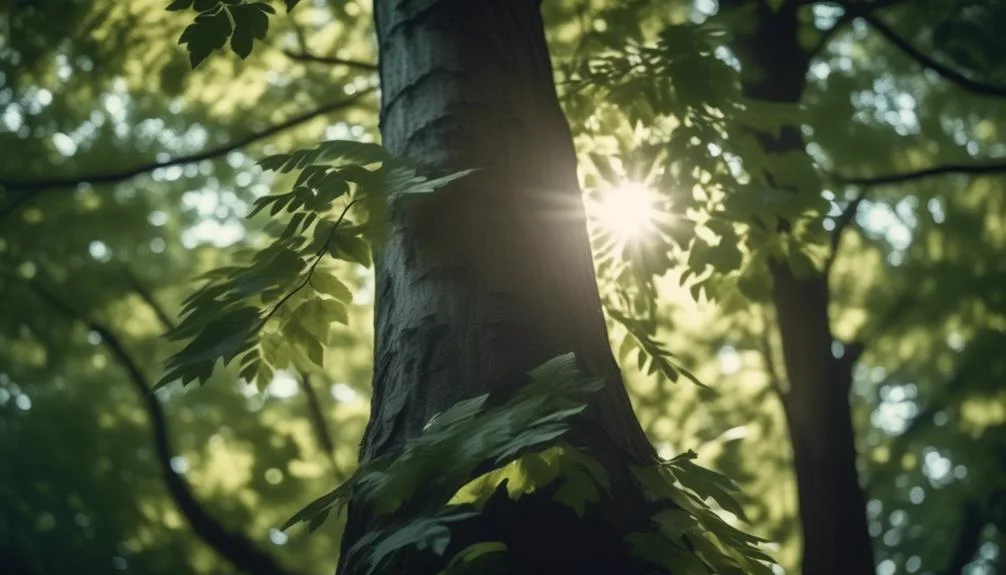Wondering if hickory trees can thrive in shade?
Many gardeners and arborists debate this topic. Known for their strength, hickory trees' ability to thrive in shaded environments is uncertain.
We aim to provide you with clear information, so you can make an informed decision for your landscape.
Ideal Conditions for Hickory Trees
To ensure the healthy growth of hickory trees, they require specific environmental conditions.
Hickory trees thrive in well-drained, deep, and fertile soils. The ideal soil quality for these trees is slightly acidic to neutral. They require consistent moisture, particularly during the establishment phase. Adequate water supply is crucial for their root development and overall health.
In terms of sunlight, hickory trees prefer full sun to partial shade. Adequate sunlight is necessary for their photosynthesis and overall growth. However, they can tolerate some shade, but excessive shade may hinder their growth and fruit production.
Additionally, hickory trees can face competition from other trees and plants for resources. Therefore, providing them with the right conditions, including soil quality, moisture, and sunlight, will ensure their vigorous growth and development.
Tolerance to Shade
Hickory trees can tolerate some shade, but excessive shade may hinder their growth and fruit production. While they're generally considered shade-tolerant, they still require a significant amount of sunlight to thrive. In heavily shaded areas, hickory trees may struggle to compete with other tree species for sunlight, water, and nutrients, which can slow down their growth and development. However, when provided with the right balance of shade and sunlight, hickory trees can adapt and continue to grow steadily.
Emotional Bullet List:
- Frustration: Discovering that excessive shade can hinder hickory tree growth can be frustrating for those trying to cultivate these trees.
- Hope: Finding the right balance of shade and sunlight can give hope for successful hickory tree growth, even in partially shaded areas.
- Determination: Despite the challenges of shade tolerance, the determination to create optimal growing conditions for hickory trees is essential for their success.
Growth and Development in Shaded Areas
Even in shaded areas, hickory trees can adapt and thrive when provided with the right balance of sunlight and shade. Shade tolerance is a key factor in the growth and development of hickory trees. They have the ability to adjust their growth patterns and leaf orientation to optimize light absorption in shaded environments.
However, it's important to note that while hickory trees can tolerate shade, they still require some direct sunlight to thrive.
Root competition is another crucial aspect of hickory tree development in shaded areas. In forests or areas with dense vegetation, hickory trees compete with other plants for nutrients and water. Understanding the dynamics of root competition and ensuring adequate spacing between trees is essential for promoting healthy growth and development in shaded environments.
Best Practices for Planting in Shade
In shaded areas, consider planting hickory trees with a focus on providing the right balance of sunlight and shade for optimal growth. When planting hickory trees in shade, follow these planting tips for best results:
- Soil Preparation: Ensure the soil is well-draining and rich in organic matter to provide essential nutrients for the hickory tree's growth.
- Tree Selection: Choose hickory tree species that are well-suited to shade conditions, such as the bitternut hickory or shagbark hickory.
- Mulching: Apply a layer of mulch around the base of the tree to retain moisture and regulate soil temperature, promoting healthy root development.
Considerations for Thriving Hickory Trees
To ensure thriving hickory trees in shaded areas, it's crucial to carefully monitor and manage the surrounding vegetation to minimize competition for resources. Root competition can significantly impact the growth of hickory trees, so regularly inspect and address any invasive plants or aggressive root systems.
Additionally, maintaining good soil quality is essential for the trees' health. Consider adding organic matter to the soil and using mulch to retain moisture and nutrients.
Proper pruning techniques can also enhance the trees' ability to thrive in shade by directing growth and reducing competition among branches.
Moreover, maximizing light exposure within the shaded area can be beneficial. Evaluate the surroundings and make adjustments, such as selectively thinning out neighboring trees, to allow more light to reach the hickory trees.
Conclusion
In summary, hickory trees can thrive in shaded areas with proper care and attention, despite their preference for full sunlight.
Ensuring rich, well-draining soil, regular watering, and mulching are essential for cultivating healthy hickory trees in less than ideal lighting conditions.
This highlights the resilience and adaptability of hickory trees, offering a broader perspective on their potential to flourish in diverse environments.

My interest in trees started when I first saw the giant sequoias in Yosemite.
I was a teenager then, and I remember thinking, “I need to learn more about this.”
That moment stuck with me.
A few years later, I went on to study forestry at Michigan Tech.
Since graduating, I’ve worked in a mix of hands-on tree care and community education.
I’ve spent over ten years helping people understand how to plant, maintain, and protect the trees in their neighborhoods.
I don’t see trees as just part of the landscape.
They are living things that make a real difference in our daily lives.
